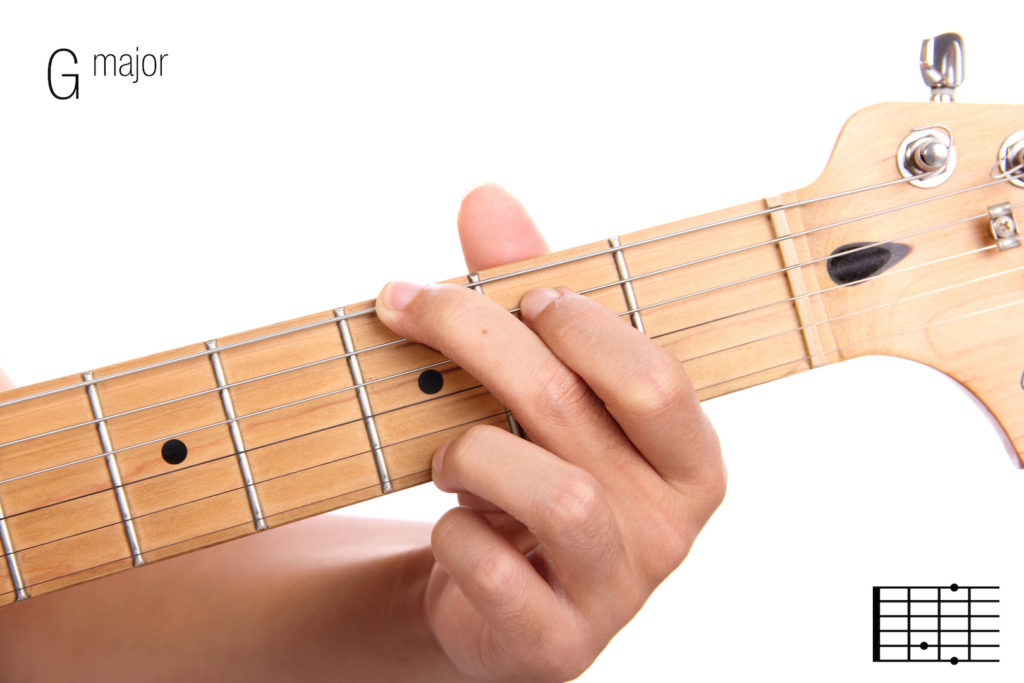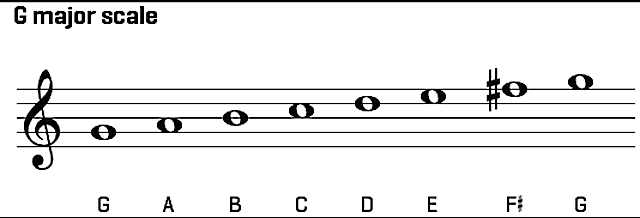G Chord on Guitar (easy): History, Chord Shapes, Major Scale & Songs in the Key G Guitar
Author: Wanda Waterman

Here it is, another article in our “Chord of the Week” series, where we share a new guitar chord every week, exploring its history, its relevance, how it’s played on the guitar, its major scale, some common chord progressions, and a few popular songs in its key.
The key of G features prominently in the works of Domenico Scarlatti and J.S. Bach, two Baroque era composers known for wafting a sense of blessedness to our ears. And, The Beatles frequently used G Major to communicate their celebrated message of love, contentment, and fun.
Table of Contents
Key Of G Guitar History Lesson: The Blessed Key

This week we’re bringing you the G Major chord, the root chord of the key g guitar, known during the Baroque era as “the key of benediction!”
So . . . want to dedicate a new church? A sonata in G major. A baby is born? Pick a hymn in G major for the baptism. The key features prominently in the works of Domenico Scarlatti and J.S. Bach, two Baroque era composers known for wafting a sense of blessedness to our ears. And the Beatles frequently used key g guitar to communicate their celebrated message of love, contentment, and fun.

It’s also sometimes referred to as “the key of the people” because of its status in both classical and popular music. Spotify backs this up, reporting that the keys of G Major and C Major beat out all the others, hands down, for the number of songs they accompany.
The key G guitar, with only one accidental (a sharp) is relatively easy to play for both piano and strings, and it’s an easy key to sing in. It’s connected to gentle emotions like contentment, gratitude, and peace.
(For a little music theory background on major scales, read this.)
The G Chord Position on the Guitar: A Bit of a Stretch, But Worth the Effort
Playing the G Major chord in its basic position does require a little tendon stretching. If your hands are small it may be a bit hard to master at first, but it has a great sound, and you’ll be using it a lot!
If you’re finding that the G chord as well as the key g guitar are hard for you to play, the good news is that any chord is playable if you practise long enough, and the Uberchord app (click for free download) can reduce the amount of practice needed by acting as a tutor, telling you exactly what you can do to improve the sound.
!function(e,r,d){var t,c=e.getElementsByTagName(r)[0];e.getElementById(d)||(t=e.createElement(r),t.id=d,t.src=”https://uberchord-backend.firebaseapp.com/uberchord-embed-sdk.js”,c.parentNode.insertBefore(t,c))}(document,”script”,”uberchord-jssdk”);
Further down the road, when you find yourself having to play progressions of chords that are hard to switch between, you can program in the chord progressions themselves and get helpful feedback. On our blog you can also find five great tips to help you learn new chords on your guitar.
Theory and Practice: The Pattern of the G Major Scale Explained
If you already know music theory (if you haven’t here’s a great place to start) you’ll know that the sequence of tones in a major key are:
whole tone – whole tone – half tone – whole tone – whole tone – whole tone – half-tone
That is, at the third and the seventh places in the scale there’s a half tone, and between all the other notes there are whole tones. This means that the scale of the key of G is made up of the notes
G – A – B – C – D – E – F#
Here’s the G scale, with G at its root and another G, an octave higher, at its summit.
On your guitar strings it looks like this:

(By the way, if you want to learn how to quickly memorise the notes on your guitar’s fretboard, be sure to read this!)
The G Major chord, which forms the root of the key g guitar scale, is made up of the notes G, B, and D— the first, third, and fifth notes of the key of G. On the guitar, using this basic G chord position, these notes arrive in this order: G, B, D, G, D, and G.
If all this is making your brain hurt, don’t worry— our blog has a great series of music theory articles to lead you through the maze. Knowing the theory behind the practice will help you to be a better musician and give you the peace of mind that comes with knowing what it all means. Learning music theory on the side is a great complement to using the free Uberchord app!
Common Chord Progressions in the Key of G Major
If you were to use every chord in the key of G Major, the following would be the chords you’d use. You aren’t strictly limited to using only the chords in the same key, but it helps to know them, so here they are:
G major, A minor, B minor, C Major, D Major, E Minor, and F# Diminished
Why are the second, third, and sixth chords minor? Because in the major scale the chords at the second, third, and sixth positions of the key are minor. That’s just how it is.
Why is the F# a diminished chord? Because in the major scale the chord at the seventh place is diminished.
The D chord can also be played as a D7. Why? Because it sits at the fifth position of the key of G, giving it the honour of being the chord that announces that a musical phrase is about to end. Play some of the chord progressions below and you’ll see what we mean.
Adding the seventh note of the key of D (C) to the D chord, creating a D7, makes the D sound even more topheavy, as if it’s about to fall over onto the root chord (G) that usually comes next, or, in cases where no chord comes next, giving the musical phrase an unfinished, “leaving them hanging” kind of sound. (If you want to know more about 7th chords and how to use them, check out this article on our blog. And if you want to go more deeply into chord progressions, check out this article series.)
Here is a great example for this from the song “Galveston” by Jimmy Webb (as sung by Glen Campbell):
!function(e,r,d){var t,c=e.getElementsByTagName(r)[0];e.getElementById(d)||(t=e.createElement(r),t.id=d,t.src=”https://uberchord-backend.firebaseapp.com/uberchord-embed-sdk.js”,c.parentNode.insertBefore(t,c))}(document,”script”,”uberchord-jssdk”);
Obviously you can’t just start playing the chords in the key G guitar and expect to make music. The following are a few common chord progressions in this key. After your Uberchord lessons you can take a little time to experiment with the following progressions to get a feel for how the chords create a sense of beginning, rising, falling, and ending, depending on their context. Most of the songs you hear are made up of combinations of these and other chord progressions. As you play them and get used to their sound, you’ll realise that you’ve heard these progressions before in many different incarnations.
- G, C, D, G.
- G, D, E minor, C.
- G, E minor, C, D.
- G, D, E minor, B minor, C, G, C, D.
- G, G, G, G, C, C, G, G, D, D, G, G. (blues)
- A minor, C, D.
- G, C, D, C.
- D, C, G.
- E minor, C, G, D.
- E minor, D, E minor, D.
Just A Few Great Songs in the Key G Guitar
Have you noticed yet that each key— and even each chord— that you play has its own particular emotional character?
The key of G is so tender and loving it can handle joyful anthems like Lynyrd Skynyrd’s “Sweet Home Alabama”
It can be a paean to life and love, like Green Day’s “Good Riddance (Time of your life)”
It can be a tender hymn to country life, like the Beatles’ “Blackbird”
It can be a simple song, like Pink Floyd’s “Wish You Were Here”
It can be defiantly tongue-in-cheek, like Queen’s “Another One Bites the Dust”
For good times and happy memories, you just can’t beat G major. The sooner you learn it, the happier you’ll be. And if you haven’t downloaded the Uberchord app yet, here are five great reasons why you should.
If you’re fascinated by music theory, then you should read some of our articles on our free blog like those on the guitar chords in c minor, the key of am guitar, as well as our article on classic rock chord progressions. Music theory is a fascinating subject once you understand how it unlocks so many secrets of how music works. Please check out our blog for more info!
References:
Cosmic Music: Musical Keys to the Interpretation of Reality, essays by Marius Schneider, Rudolf Haase, and Hans Erhard Lauer
This is Your Brain on Music: The Science of a Human Obsession, by Daniel J. Levitin
http://www.digitaltrends.com/music/whats-the-most-popular-music-key-spotify/
Characteristics of Musical Keys
A History of Key Characteristics in the Eighteenth and Early Nineteenth Centuries, by Rita Steblin
The 10 Most Used Chord Progressions in Pop and Rock and Roll









I try to use the link to the app, to practice the chord progression, the phone open the apps, show that it is charging and suddenly the apps crash out, I think with the new development 2.0 the link doesn’t work…
Luis, right you are. The new version 2 contains so many changes that we broke a couple of things. With the next release v2.1.5 this will be fixed again. Apologies!